




The Hospital of the Five Wounds is a half-timbered house in the city of Hildesheim in Lower Saxony, Germany. It is in the southern part of the old city center, opposite St. Godehard and behind St. Nicolai's Chapel.





The Hospital of the Five Wounds is a half-timbered house in the city of Hildesheim in Lower Saxony, Germany. It is in the southern part of the old city center, opposite St. Godehard and behind St. Nicolai's Chapel.
In 1770, a large half-timbered house was built in Hildesheim to house two different hospitals which had already been founded several centuries before. The ground floor was given to the Hospital zu den Fünf Wunden (Hospital of the Five Wounds) and the upper floors to the Hospital Sankt Nicolai (Hospital St. Nicolai). Later, both hospitals were united to form the Vereinigte Hospitäler (United Hospitals). The building, however, kept the name Hospital zu den Fünf Wunden. [1] The name derives from devotion to the holy wounds inflicted on Jesus during the crucifixion, a pious practice traditionally associated with works of mercy and social justice (in reformation England the Pilgrimage of Grace was undertaken by Catholics protesting their loss of charitable institutions and religious freedoms, under a similar patronage). From the 19th century on, the building was used by a nearby Catholic hospital which still exists today.
During World War II, the Hospital of the Five Wounds was only slightly damaged by bombs on 22 February 1945 and on 22 March 1945, [2] and the damage could be repaired very soon. The building was renovated in 1981. Today it is used as a training college for nurses.
The Hospital of the Five Wounds is one of the largest half-timbered houses in Hildesheim. The address is Godehardsplatz 9–11 which is a large square in front of the Romanesque St. Godehard, but actually it is in a small and rather steep side lane. The building has four floors and a half-hip roof.
The ground floor which was built of rubblestones has a representative baroque portal above which the year of construction (1770) is indicated in Latin in a noteworthy chronogram:
CVra BonIfaCII, prIMo, qVo praefVIt Anno Abbas SpeCtatos CoLLoCat HosCe Lares.
One M = 1000, six C = 6 x 100 = 600, three L = 3 x 50 = 150, three V = 3 x 5 = 15, five I = 5 x 1 = 5, 1770 altogether. [3]
Above the portal, which was the main entrance of the building, the coat of arms of an abbot can be seen as well. The upper floors, which housed the St. Nicolai Hospital, were built in a half-timbered style. This hospital had its own entrance in the east of the building where a statue of the patron saint can be seen.

Hildesheim is a city in Lower Saxony, in north-central Germany with 101,693 inhabitants. It is in the district of Hildesheim, about 30 km (19 mi) southeast of Hanover on the banks of the Innerste River, a small tributary of the Leine River.

Aschersleben is a town in the Salzlandkreis district, in Saxony-Anhalt, Germany. It is situated approximately 22 km east of Quedlinburg, and 45 km northwest of Halle (Saale).

Hildesheim Cathedral, officially the Cathedral of the Assumption of Mary or simply St. Mary's Cathedral, is a medieval Roman Catholic cathedral in the city centre of Hildesheim in Lower Saxony, Germany, that serves as the seat of the Diocese of Hildesheim. The cathedral has been on the UNESCO World Cultural Heritage list since 1985, together with the nearby St. Michael's Church because of its unique art and outstanding Romanesque architecture.
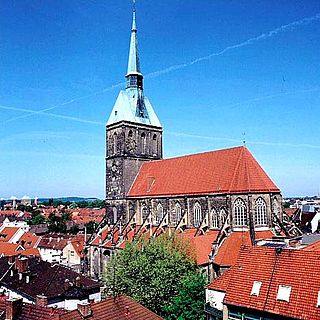
The church of St. Andreas is the principal Lutheran church of Hildesheim, Germany, not to be confounded with the Catholic Hildesheim Cathedral. Its tower is 114.5 metres (376 ft) tall, making it the tallest church tower in Lower Saxony; it is accessible and offers a panoramic view of both the city and surrounding countryside.

Gardelegen is a town in Saxony-Anhalt, Germany. It is situated on the right bank of the Milde, 20 m. W. from Stendal, on the main line of railway Berlin-Hanover.
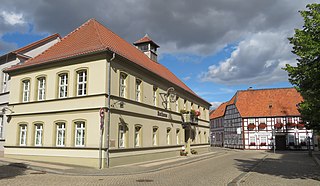
Osterburg is a town in the district of Stendal, in Saxony-Anhalt, Germany, situated approximately 22 kilometres northwest of Stendal.

Oettingen in Bayern is a town in the Donau-Ries district, in Swabia, Bavaria, Germany. It is situated 29 km (18 mi) northwest of Donauwörth, and 14 km (8.7 mi) northeast of Nördlingen.
Sorsum, a district of the city of Hildesheim, is a small village in northern Germany.

The German city of Hildesheim, c. 30 kilometres south of Hanover, was the target of eight Allied air raids in 1944 and 1945 and suffered considerable bomb damage.

Køge is a seaport on the coast of Køge Bugt 39 km southwest of Copenhagen. It is the principal town and seat of Køge Municipality, Region Sjælland, Denmark. In 2023, the urban area had a population of 38,588.

The Upended Sugarloaf is a half-timbered house in the city of Hildesheim in the federal state of Lower Saxony in Germany.
Lappenberg is a historic street in Hildesheim, a city in Lower Saxony in Germany. It was the center of the Jewish community.

The Historic Market Place is a historical structure in the city of Hildesheim in Lower Saxony, Germany
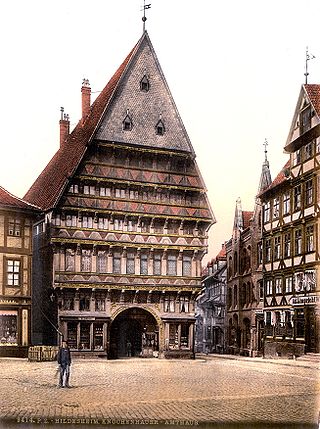
The Butchers' Guild Hall is a half-timbered house in Hildesheim in the federal state of Lower Saxony, Germany.

Marienburg Castle is a well-preserved Romanesque castle in Hildesheim, a city in Lower Saxony, Germany.
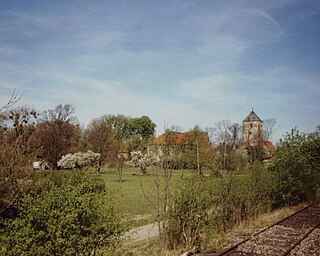
Steuerwald Castle is a Romanesque castle in Hildesheim, a city in Lower Saxony, Germany.
St. Bernward's Church is a Catholic church in the city of Hildesheim in Lower Saxony, Germany. The name refers to the bishop Bernward of Hildesheim (960-1022) who was canonized by Pope Celestine III.
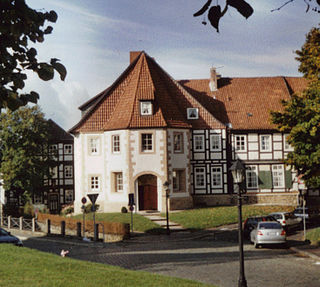
St. Nicholas' Chapel is a former Roman Catholic parish church in the city of Hildesheim in Lower Saxony, Germany. It is dedicated to Saint Nicholas and is located in the southern part of the old city centre, opposite St. Godehard.
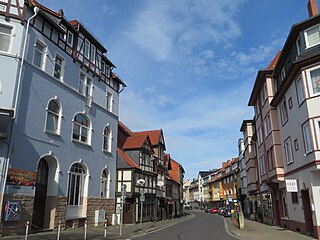
Moritzberg is a quarter in the city of Hildesheim in Lower Saxony, Germany. It is on a hill in the west of the city, about a mile from the Cathedral. It was an independent market town until 1911.

Gelber Stern is a historic street in Hildesheim, a city in Lower Saxony in Germany.